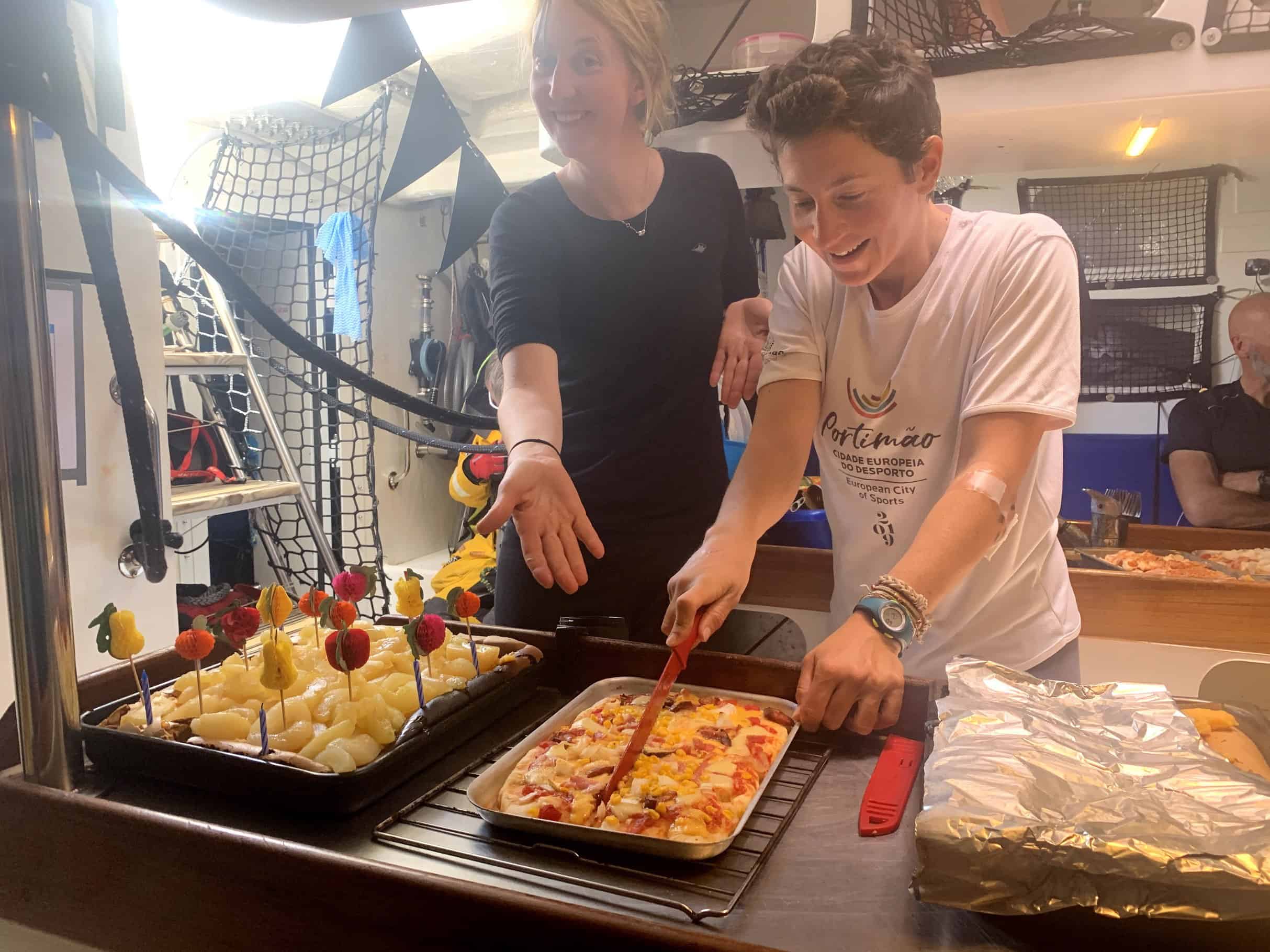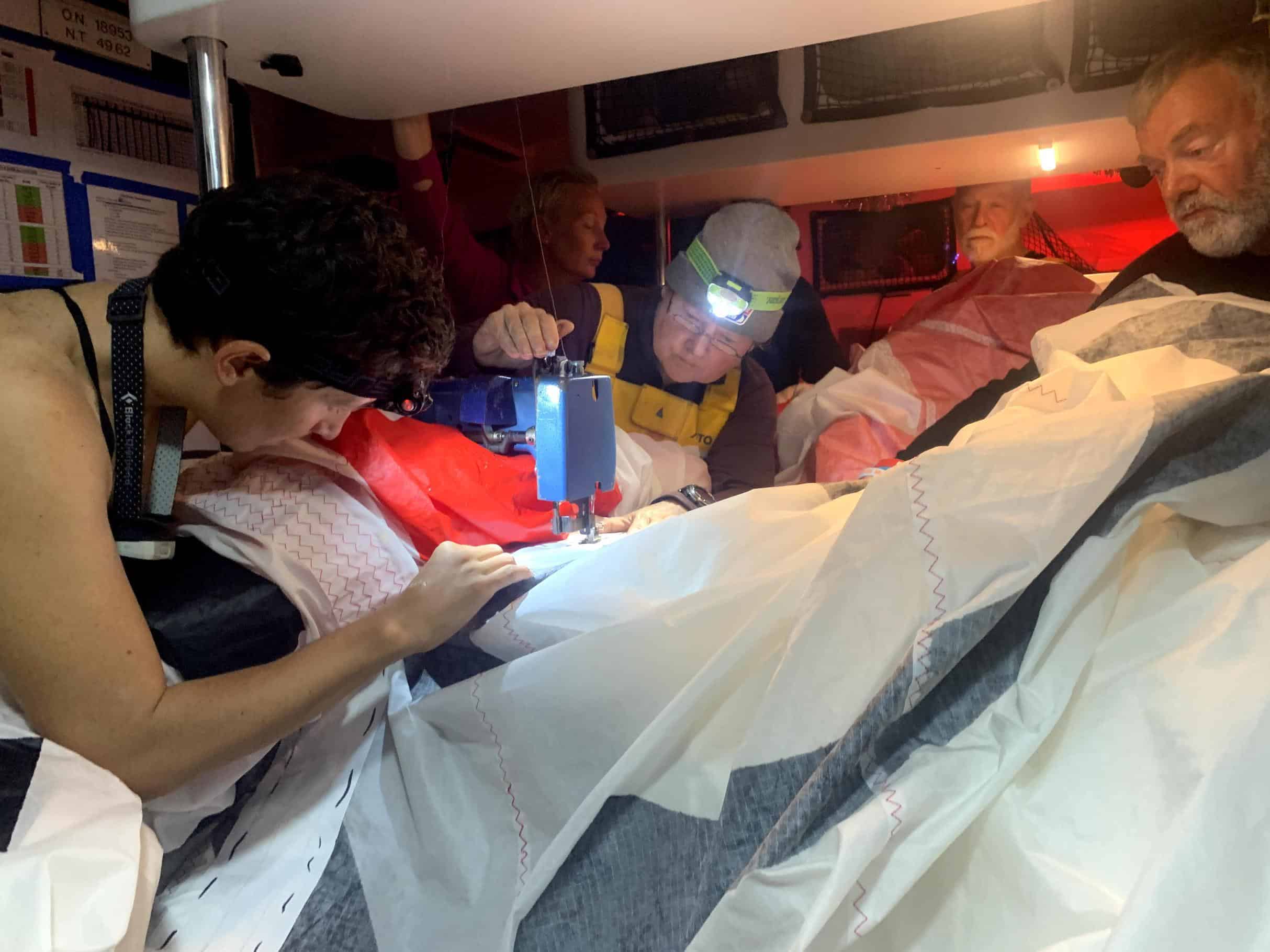With most of the world in some form of lockdown, learning how to stay sane in isolation is a battle we’re all trying to navigate. Here Sandra Marichal, Ocean Racer on the Clipper Round the World Yacht Race 19/21, shares some much-needed advice that will help keep cabin fever at bay. Sandra will also be joining us during our next Facebook Live session, Breathing Through The Storm, this Wednesday, 15 April. Set your reminder here.
“As a sailor, I know a thing or two about isolation. As part of the Clipper Round the World Yacht Race, I lived for seven months on a 70ft yacht with 20 other odd people, spending weeks, months crossing oceans. Most people associate sailing with freedom, and it’s true, we can go anywhere. But the reality is that we are confined by the means to our freedom. We’re stuck on the boat and committed to the journey – and that’s usually the side of the adventure we don’t talk about.

How can one explain the tightness, proximity, body odours, claustrophobia, lack of intimacy, lack of personal space, absence of entertainment, drugs, sex or alcohol? The impossibility of walking away from a difficult conversation, an annoying voice, a noise that wakes you up and triggers anxiety every time you hear it? How to make people feel what it is like to be awakened after three hours of bad sleep to someone above me flipping their stinky feet in my face and someone below me trying to find their kit in pitch darkness? Or to get dressed by swapping one dirty t-shirt for a slightly less dirty one? How to explain the remoteness, the sometimes-suffocating feeling of the infinite horizon and the single-mindedness of the mission: to make the boat go faster?

In many ways, today’s self-isolation is a lot easier for me than the confinement of the boat. For one, I have space. I can sleep when I want, eat what I want. I can run to the shops for fresh food, and I can do yoga on a flat-stationary floor. I have Netflix, Instagram and an unlimited library of music. Onboard, these would have been luxuries.
But the isolation wasn’t always easy. The first four days and the 4th week felt particularly horrific (especially as it was meant to be a 3-week race) – my mood and energy were low, I was pretty much my worst self – which isn’t ideal for friends, family or crewmates. So I thought I’d share some tips on how to not only manage but harness self-isolation to make it the most extraordinary time of your life.
1. Accept and let go
You’re stuck. It sucks. I’m sorry. This shouldn’t be normal, but unfortunately, now it is. The first thing to do is to accept it.
When we got on the boat for the first time and knew we were going to be stuck on it for a year, we had to operate a mind-shift. The boat was now ‘home’ and ‘work’ while the stopover ports became ‘holidays’. We couldn’t survive offshore by continually thinking about our distant life onshore. We’d get mad. We had to accept that this is it: the boat is our world, and it doesn’t matter how long we’re on it. To survive this, you must operate that shift too. Realise how lucky you are to have a place to stay and enjoy that space – regardless of how long you’ll be in it for. The danger is to treat this as time-off and slip into a ‘laissez-aller’ lifestyle and risk losing all of your good healthy habits. Focus on what you can control and let go of everything else.
You’ve got a chance to redesign your lifestyle from scratch, so where will you start? What will you do differently? What will you try? Isn’t this a more exciting way to look at what’s happening? I think so too…
2. So what do we do now? Have a plan!
Ocean racing is about going as fast as possible for as long as you can, stuck in cramped, uncomfortable conditions. But we have a destination. And with that, an extreme sense of focus: we aim to go from one port to another in the fastest and safest possible way. We have no idea how long it’ll take. We don’t know what we’ll find on the way. But we know for sure it’ll be hard and we’ll have to face many difficult challenges. My suggestion is to find your destination – your goal. How many times have you told yourself “if only I had more time…” well guess, what, now you have it! So do something with it! Fitness, cooking, learning something new, get started and stick to it every day.

Don’t get me wrong; it’s easy to slip into stillness and laziness when you’ve got all the time in the world. If that’s the case, I found it useful to make a list of jobs to do in the house and share it with your partner, friends, or family who live with you or via WhatsApp during your morning check-ins.
On the boat, whenever we’d hit a wind hole, we’d open the job list and start working on things we usually do when in the port: clean the bilges, wipe the boards, repair the heads (toilets), tidy, splice – even exercise… we would always be busy (between the occasional siesta and chess game).

3. Don’t count down, don’t count up. Organise your days around a strict routine.
At sea, counting down days is playing a dangerous game with moral. There are inevitably more left than you initially expect, and watching estimated arrival dates fall back is crushing. On the boat, I never knew what day it was, but I always knew what time it was. We would organise around three important moments: sunrise, sunset and midday– coinciding with our three meals. At this point, both watches (teams) meet for 30 minutes to discuss strategy, weather and other sailing matters.
In between dawn, dusk and lunch we keep up a strict routine and rota. 6 hours on watch, 6 hours off during the day, then 4 hours on, 4 hours off and 4 hours on at night. Then we start all over again. Every time we followed the same flow: 30 mins to wake up, go to the heads, dress up, check the onboard navigation software for our position amongst the fleet, weather forecast and last few log entries, put on foulies and lifejacket, go on deck, listen to the watch handover, check cockpit, winches, lines, foredeck, prep the next possible evolution, run through positions and actions, be ready to take over the helm and constantly think “how can I make the boat go faster?” Stay hydrated, snack, check the job rota, do your job, help others with theirs. Complete watch, proceed to deliver watch handover to the upcoming watch, go down below, remove lifejacket and foulies, go the heads, refill water bottle, have a wipe, get in bunk, fall asleep. And wake up again for the next watch to repeat…
So how do we get a sense of progress? Well, we look at the miles gained over the other boats in the last 6 hours and the miles to the next weather system. The idea was not to count how much time it’d take to get there but rather to focus on what we could do within that allocated time to get there as fast as possible. Every hour and minute was spent doing something towards that objective. We kept ourselves busy!

So in the current quarantine situation, work with your objective (see above!) – define and track metrics to measure your success. And a tip to keep regular: know how food and drink regulates your mood and energy levels. On the boat, we would all eat our porridge at the same time – that meant we’d have our boost of low GI energy when it was most important, and our intestinal transit was activated when we had time to do what we needed to do (read: poo).
4. Disconnect. Shut it down. Turn it off.
As technology becomes more and more integral to everything we do, it can sometimes distract you from what matters most: you. In these times of isolation, everyone is craving connection. So we connect – with colleagues, friends and family. But by being hyper-connected, constantly on Facebook, Instagram or Tik Tok, you’re missing out on the incredible experience of being by and with yourself!
At sea, we’re barely connected. The Satcom system allows us text email – an extremely expensive solution, restricted by the number of characters, so we tend to use this for emergency only. Because you’re counting words, you realise you can say lots…by not saying much after all – funny how meaningful an ‘I love you’ feels like when these are the only words you send…

Onboard, we have no choice but to escape connectivity and are forced to live without a digital identity. There’s an exceptional relief in not having to connect – life is a lot simpler. First, the silence. The void. The lack of notifications. Immediacy disappears and things take time – you actually see time passing by. An hour feels like an hour. The attention comes back, senses are sharper. Colours become more vivid and sounds are clearer. You’re more present in everything you do and take part in meaningful conversations. Active listening is not an effort anymore, it becomes the norm. And just like that, naturally, you’ve become connected again…to yourself! Disconnected to the world but very present in it.
So here’s my suggestion to you: close that laptop, turn your phone in flight mode, switch the TV off and look up, observe, listen. For five minutes. Don’t try to do anything, just be present. Feel the time passing by. I guarantee you’ll feel happier in these long minutes doing nothing than during your hours spent looking at a screen!

5. Live on less
What better time to become minimalist than when you have no choice but to live with less? We’ve been in self-isolation for nearly four weeks in the UK, and my bank account is strangely still. I haven’t gone shopping, and since delivery takes ages, I don’t bother buying much online either. I consume less, eat less and drink less (ok, that last one isn’t true…but supporting wine producers is a good thing, right?).
At sea, we discover that richness is not about how much we have but how little we need. We board the boat with a maximum of 20kg of personal belongings. So my year of clothing looked like that: 10 (unsexy) merino wool panties; five bras; five short sleeves; five long sleeves; three bottoms; two shorts; one pair of jeans; two cute t-shirts; and I made a point to carry a mini handbag, a lululemon pair of leggings and my pair of running shoes with me as my personal luxuries. Disclaimer: I would buy one dress at each stopover which I would ship back to London, Paris or Singapore before boarding for the next race.
And it was enough! I promise you. You do not need all the stuff you have. So here’s your challenge: do not buy anything non-consumable. Wear the same clothes. And only buy what’s necessary. You’ll realise that the root of sustainability is in the art of sustaining yourself with limited resources.

One way I came to this realisation was when we started cleaning our trash bags to remove the organic left-overs so the bins wouldn’t stink after weeks at sea. The process involved reopening the bag, sorting the trash, washing it and stuffing the big containers with all the small pieces of packaging. It was alarming to realise how much plastic we throw away in a couple of days…But the shock came when we realised we were coming short on resources: on gas, on fuel and therefore power and water. We had to start rationing. And that…I wish it to no one. Read my Crew Blog to learn how we overcame that challenge.
6. Find the sleeping schedule that works for you
It’s been proven by science; humans cannot focus and work eight hours in a row. It is an idealistic heritage from the industrial age. Most people feel most productive at specific times during the day. Mine are from breakfast till noon and 5 pm till 2 am. Over the years, I have acquired the freedom to learn to manage my own productivity, on my own time. And by the time I was preparing my Round-the-World race, I could effectively and successfully perform at work, go through a daily physical and mental prep and get my life organised and gear ready for the big Race Start day. The trick? Listening to your body, don’t force yourself to stay behind the desk or taking meetings when your mind is telling you to rest and sleep instead. This is the greatest benefit of working from home! Rest when you feel like it (or when you can if you’re a parent!) and you’ll realise you probably only need a 30min nap to get back on your feet again.
Funnily, we were following a similar pattern on the boat. No one was ever holding the same position for more than 30 mins at night. Trying to stay awake in front of a computer at 11 pm while listening to a boring call is one thing, but trying to steer straight in the middle of a pitch-dark night, under spinnaker, while making sure your crewmates are safe is a whole different challenge.
My suggestion is whenever you feel like taking a break – take it. Let your team and boss know that you need it as if your life and the life of your family was at stake. Even if it means you’ll work longer in the evening. I’m a fervent believer in day-time naps and night-time work. Sleeping when you need to ultimately results in a more productive time awake…and you’ll realise that you’ll sleep more in aggregate! Would love to follow this but can’t sleep? Here’s a TED Talk by Arianna Huffington which I found helpful.
7. Beware: negativity spreads dangerously fast
Negative thoughts creep in subtly at first. They sound like sarcasm, irony, or a plain statement of facts – but when the facts are shit, it can be poisonous. And with an echo chamber, a small space and complex conditions, they can quickly turn into depressive thinking and spread amongst the rest of the crew. At sea, when the situation was challenging, we would be told by our skipper to find a space – anywhere on the boat – to isolate ourselves in our mind to reset and re-establish a neutral or positive take on what we were going through. It’s harder to turn everyone’s mood back to its happy state once it’s been sacked than to keep it steady during hardships. The trick is to be aware of your mood. Accept that your energy will go up and down and know that it is ok to be down sometimes – even if it doesn’t feel or sound like you. The context is different and so your mind will react differently. Be aware of your words, they define your reality and that of those around you. The moment you start to feel low, acknowledge it and do something about it. Go meditate, breathe, walk, exercise, sleep, talk about it with your therapist or coach, read; just do whatever works. Take care of your mental state to not impact the state of your isolation mate.

8. Practice self-care but don’t overdo it.
All these ads on my newsfeed for face masks, massage, cream etc…make me laugh. I mean I get it, we’re a captive market, and we technically have time to take care of our bodies. But do we really ‘need’ it? Onboard, my’ beauty routine’ was to disappear during my night watch for 30 mins to have a poo and brush my teeth (yes, both once a day and only if the weather allowed). When the skin on my face would become rough, red, spotty, I would wash my face with soap and fresh water and put a bit of face cream on – maybe once every three or four days. I would spray deodorant extensively inside, outside and all around my body and clothes – but would make sure to alert my crewmate before I sprayed the accommodation corridor and triggered an asthma crisis.
A lot of people asked about showering on the boat. We didn’t. So do shower as part of your quarantine routine, or, if you truly want to see how far your body can cope – don’t! And it can cope very easily. You’ll stink most on days three to five, but after that, the body odour will dissipate as the body will start cleaning itself. PS: this only works if you stay outside or take a consequent amount of fresh air and if your isolation mates don’t shower either. As for your hair ladies, don’t wash it, it will wash itself… eventually.
On this final smelly note, I hope these tips would help you during your confinement at home. If you want to know more about my Clipper Round the World Yacht race, follow my Facebook & Instagram page @sandramarichalofficial
And if you’re interested to know more about how sailors cope with isolation, you’ll love these:
Dee Caffari’s Isolated but not alone blog
The 11th Hour Racing Sailing team “Self Isolation Hacks from Offshore Sailing“
I live alone at sea. Here’s how to be happy in isolation by Susan Smillie
The Herald Coronavirus: the people who chose extreme isolation, and what we can learn from them
And if this wasn’t enough and you’re still feeling miserable, then read this article to make you feel better

